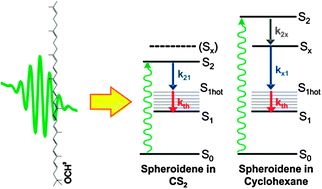Solvent-dependent activation of intermediate excited states in the energy relaxation pathways of spheroidene
Abstract
In

- This article is part of the themed collection: Ultrafast chemical dynamics
* Corresponding authors
a
CNR-IFN, Dipartimento di Fisica, Politecnico di Milano, P.za L. da Vinci 32, Milan, Italy
E-mail:
giulio.cerullo@fisi.polimi.it
Fax: +39 02 23996126
Tel: +39 02 23996164
b
Madrid Institute for Advanced Studies, IMDEA Nanociencia, Madrid, Spain
E-mail:
larry.luer@imdea.org
Fax: +34-91-497-68-55
Tel: +34-91-497-68-49
c
Department of Chemistry, University of Connecticut, U-3060, 55 North Eagleville Road, Storrs, USA
E-mail:
harry.frank@uconn.edu
Fax: +1 860-486-6558
Tel: +1 860-486-2844
d
University of Glasgow, Institute for Molecular Biology, Glasgow, UK
E-mail:
richard.cogdell@glasgow.ac.uk
In

 Please wait while we load your content...
Something went wrong. Try again?
Please wait while we load your content...
Something went wrong. Try again?
M. Maiuri, D. Polli, D. Brida, L. Lüer, A. M. LaFountain, M. Fuciman, R. J. Cogdell, H. A. Frank and G. Cerullo, Phys. Chem. Chem. Phys., 2012, 14, 6312 DOI: 10.1039/C2CP23585D
To request permission to reproduce material from this article, please go to the Copyright Clearance Center request page.
If you are an author contributing to an RSC publication, you do not need to request permission provided correct acknowledgement is given.
If you are the author of this article, you do not need to request permission to reproduce figures and diagrams provided correct acknowledgement is given. If you want to reproduce the whole article in a third-party publication (excluding your thesis/dissertation for which permission is not required) please go to the Copyright Clearance Center request page.
Read more about how to correctly acknowledge RSC content.
 Fetching data from CrossRef.
Fetching data from CrossRef.
This may take some time to load.
Loading related content
